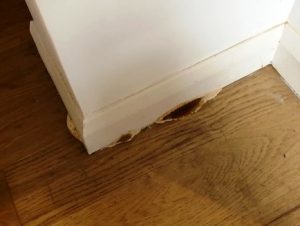 The Survey and Report: Our PCA trained surveyor encountered Dry Rot (Serpula Lacrymens) affecting the front reception of the ground floor in a North London property. This was evident from the fruiting body of the rot appearing below the skirting board. These reddish/brown brackets are very common with Dry Rot, however, this fungus has many guises and colours dependent on age and the environment it is in.
The Survey and Report: Our PCA trained surveyor encountered Dry Rot (Serpula Lacrymens) affecting the front reception of the ground floor in a North London property. This was evident from the fruiting body of the rot appearing below the skirting board. These reddish/brown brackets are very common with Dry Rot, however, this fungus has many guises and colours dependent on age and the environment it is in.
The contagious and destructive nature of Dry Rot requires immediate attention if further deterioration of the building fabric and integrity is to be avoided. Dry Rot not only feeds on timber but can traverse masonry in order to find new sources, often travelling through walls to external areas.
A full report was issued to the homeowner in our standard 24-hour turnaround.
Work Commencement: The initial tasks for our team were to 1) identify and prevent the ingress of water required for Dry Rot development 2) protect the area with polythene sheeting to mitigate for dust and spore migration to other areas of the property. This permitted removal and bagging of the contaminated timber floor in the front room where Dry Rot was visible above and below the floor in the sub-floor void.
The point of water ingress was found to be a hole where services entered the building by the front wall (left-hand picture), this was proven by pouring a bucket of water on the ground outside. It was found to be tracking into the sub-floor area as shown in the right-hand picture, we now had the prevention in hand by sealing the entry point and receiving the all-clear to remove timbers, rubble and masonry so we could treat the contamination ahead of the timber floor replacement.

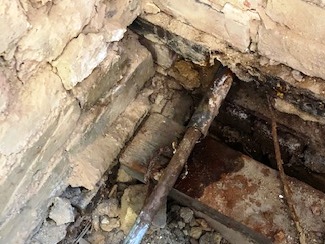
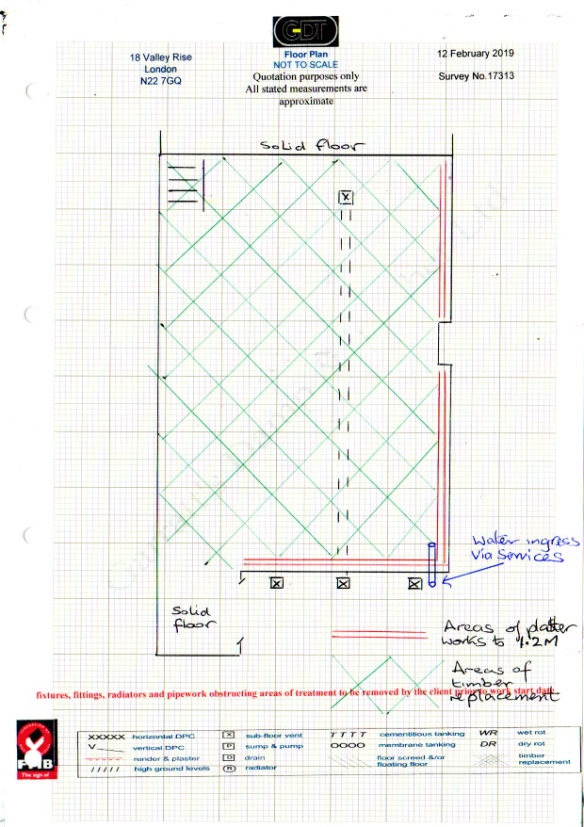
Additional Activity: Exposure of the front room enabled a view into the rear reception where the outbreak had extended under the flooring by two to three metres. Such extensive growth is not uncommon. This required a revised floor plan and client approval for a full floor replacement, an undesired but essential task.
This terraced property had three sub-floor vents (air bricks) along the front external wall but none to the rear. This, coupled with the deep infill of sub-floor rubble (two-foot deep in parts) meant the whole underfloor environment was denied fresh drying airflow rendering it stale and humid with condensation issues.
The high humidity in the sub-floor void resulted in the Dry Rot assuming cotton wool-like appearance that can be seen hanging from the joists and wall plates, feeding on and destroying the structural integrity of the timbers.
Our works also required the extensive removal of the rubble infill as this was contaminated with dry rot mycelium, also containing thousands of spores waiting dormant but ready to grow with any future presence of water. A time and skip consuming activity.
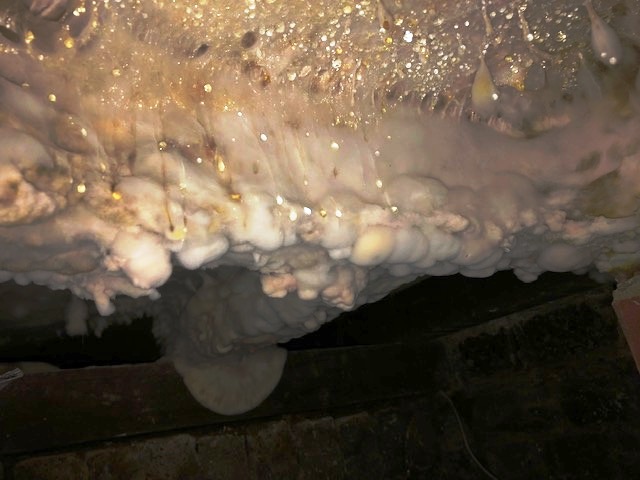
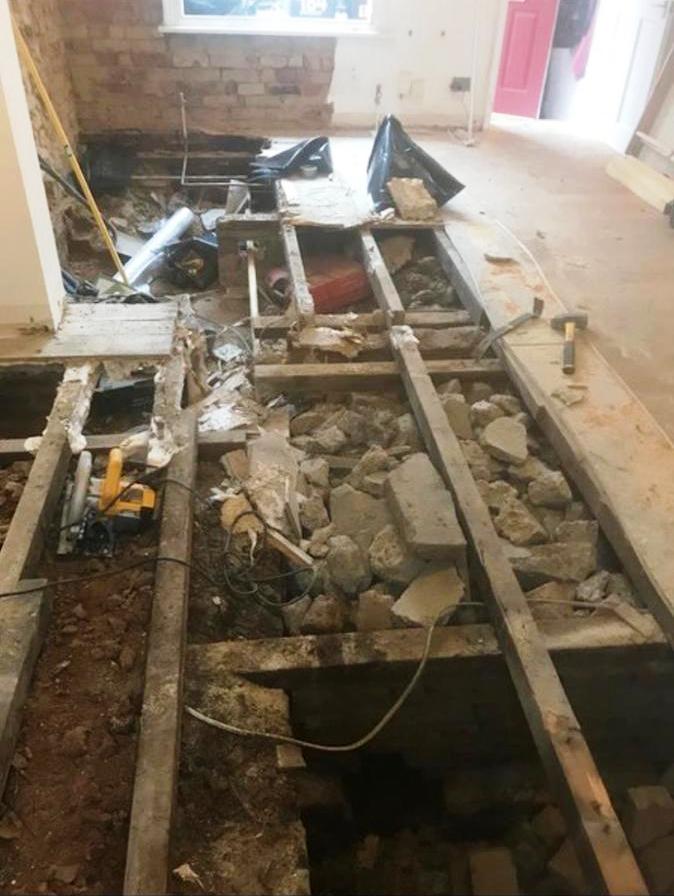
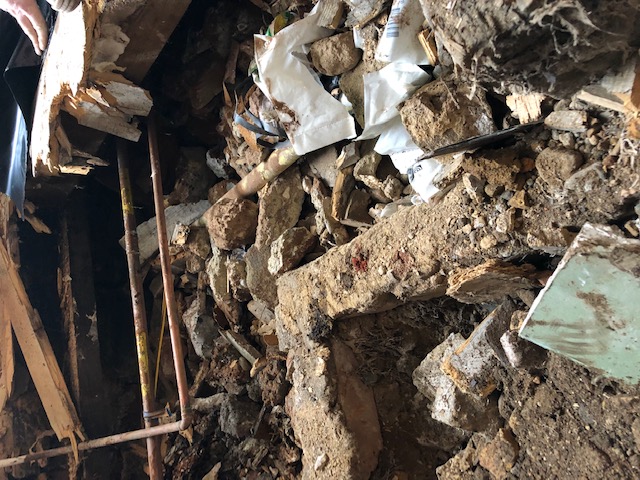
Once the rubble was removed, it was clear that the existing sleeper walls (for bearing wall plates/joists) were of poor construction, damp and contaminated. Removal and replacement were required for the new floor to remain protected from rising damp.
Ventilation: The sub-floor vents to the front wall were replaced with new, more efficient versions. The centre one (see plan above) was ducted to vent well into the rear reception, this enabled airflow to this stale area that had no vents due to the solid floor extension behind.
Having removed the contaminated timbers and rubble, the plaster and render were removed from walls, where contaminated to 1.2M high. Some of the party wall and the front wall in this instance.
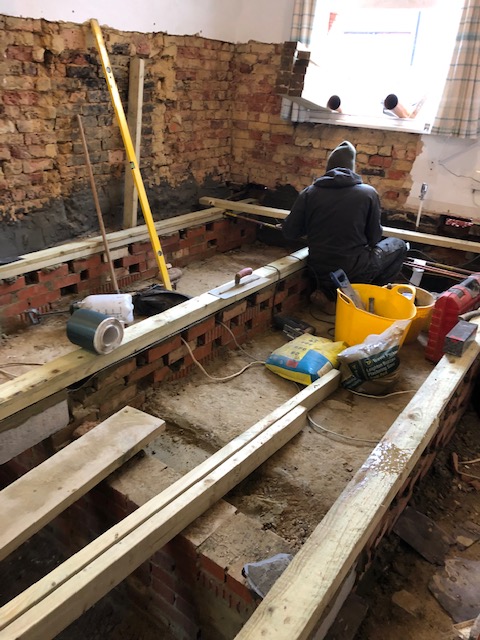
The installation of new wall plates and joists utilised C24 grade treated timbers that offer good strength and protection. All cut ends were treated as a matter of course.
The four sleeper walls and wall plates were constructed using approx 1M spans resulting in a truly solid skeleton to take the final 18mm ply flooring, stable, flat base for the planned oak block finish. The positioning on sleeper walls close to flank/party walls retains floor stability whilst ensuring new timbers are not set into lower brick walls, a poor practice that can compromise timbers going forward.
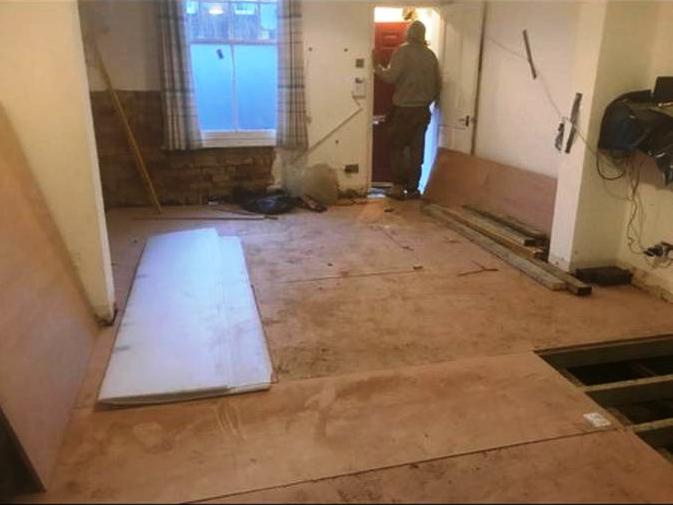
Sterilisation and Re-Instatement: The exposed brickwork and masonry was sterilised to protect against any possible future activity. New damp-proofed honeycombed sleeper walls were constructed in order to take the new timber wall plates (these support the joists and boards above).
The deliberate gaps left by omitting bricks in the sleeper walls (honeycombing) allow improved airflow and a drier environment all-round.
Where new walls were constructed, the damp proof membrane is utilised to prevent groundwater rising up the courses and affecting any new timbers set on top.
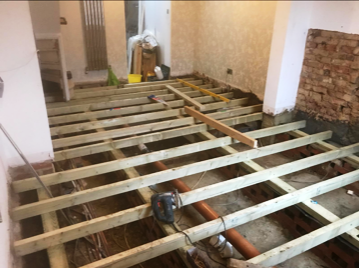
The finished floors we install are often more level across width/length than the original floors we remove, especially in older and/or rot affected properties where historic ageing and movement tells a tale.
The ducting used for sub-floor ventilation to rear reception can be seen in the picture to the right; the joists can be sitting on the timber walls plates ready for the plywood sheeting to be laid and fixed. A waterproof slurry can also be seen applied to lower walls prior to rendering and plastering works.
With the flooring and other low-level works completed, the sterilised walls were rendered using a Sika waterproof mix and then skimmed with professional finish plaster. The subsequent fitting of skirting boards was conducted by the client’s own builder once the drying of our works was completed. The skirting required glueing, not screwing, into place - this prevents the puncturing and compromising of our waterproof rendering.
The finished remedial works, ready for the relevant trades to lay the desired floor finish (block/carpet/tile/laminate) at any time and for the walls to be decorated once dried, often four-six weeks.
The materials we use in our day-to-day works are always of high quality, which enables us to offer our guarantees without concern; a benefit to us and to the client.
The works entailed six days of varied activity for our technicians who used a whole host of their skills, a satisfying project that resulted in a very satisfied customer who now held a laminated 20-year guarantee for our works. The guarantee was in the property name, not the customer’s, therefore an admin and cost-free transfer to new owner is simple upon any future sale of the property.
The duration of works experienced a daily visit from our works manager and at least two visits by our surveyor who was the client’s first point of contact. Customer service, regular contact and correspondence is a keystone of our work ethic. The images used in this study are also standard practice as client’s often request the before/during/after pictures for their records.
We hope we can offer the same well rounded and professional service to yourself one day.
Please feel free to call if you wish to discuss Dry Rot or any other damp issues affecting your property.
Case Studies
-
2022 British Standards for East London Flooded Basement
The weather in London in 2021 was particularly wet, or so it felt in a property in Leyton, East London,…
-
Bespoke Waterproofing for High-End London Shop Unit
When the basement area of a high-end shop in Chelsea was found to be inches deep in water, one too…
-
Standard Damp Proofing – Windsor SL4
The client instructed Garratt’s to conduct a damp survey and offer considerations related to any remedial works as required. The…
Archived Case Study
Recent
-
18 Mar 2024
How to Get Rid of Damp in Bedrooms
While it may seem more logical that kitchens and bathrooms are more prone to damp, it may be surprising for…
-
13 Nov 2023
Benefits of Tanking Your Basement
While basements have been a staple of home construction in multiple countries, they are still a relatively new concept in…
-
13 Nov 2023
Taking Action on Fixing Damp
Damp is a widespread problem in properties across the UK; however, this doesn’t stop the fact that it’s a serious…







